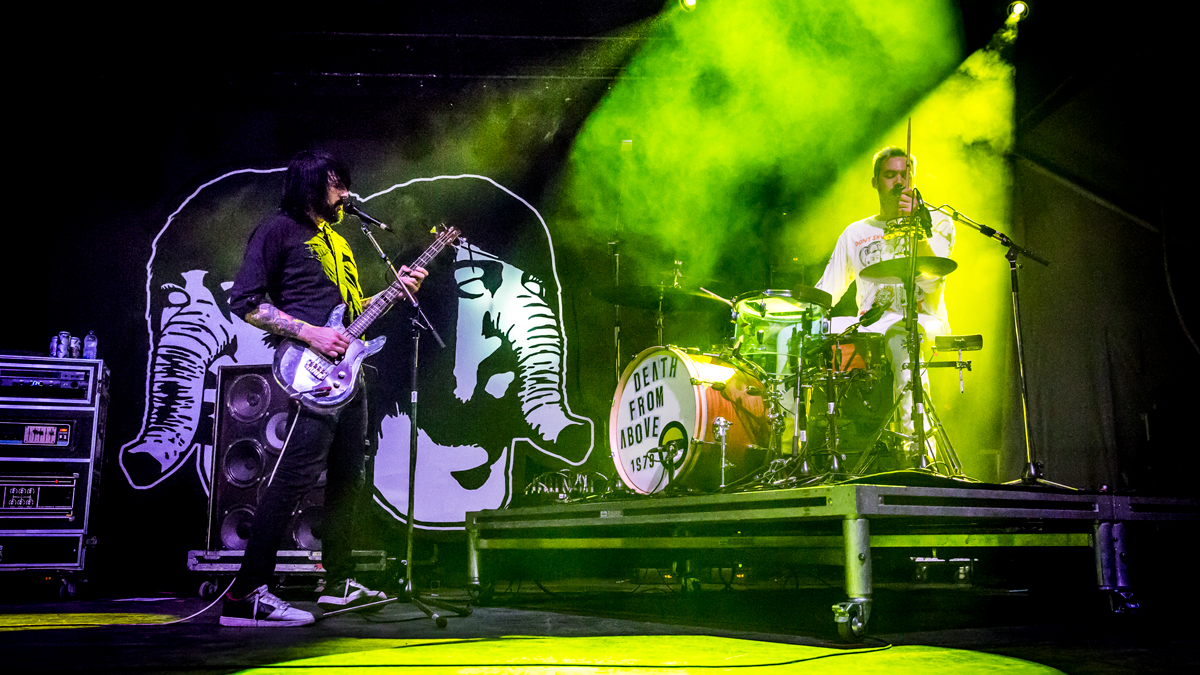Death From Above 1979's Jesse Keeler: "When I first tried a Dan Armstrong bass, I was like, 'Wow, this neck is so small, and I’ve got all these extra frets. This is awesome!'"
The pioneering two-piece's riffer-in-chief on his love of a certain transparent bass, why he had to abandon his 1971 Rickenbacker 4001 and the making of new album Is 4 Lovers

“I’ve been a farmer for a while,” says Jesse Keeler, bassist with the Canadian duo Death From Above 1979. “I live in a 198-year-old farmhouse, about halfway between Toronto and Ottawa. When I was a kid, I was interested in the concept of having a place out in the country, because I wanted to make my own Big Pink.”
Keeler’s referring here to the Big Pink country house in New York state where Bob Dylan and The Band recorded in 1967.
“My dad, Fred Keeler, grew up with all those guys, because he was a musician too. They were all friends and they all shared gear and stuff.
“He had a fair bit of success in Canada. You know, he’d be opening for the Rolling Stones, and he was the first guitar player in Triumph, and stuff like that. But he was always a player – I don’t think he wanted to be a star. He certainly didn’t want to be famous. He just wanted to play, and he figured that at some point, people would give him money for doing a good job. Paul Butterfield asked him to be his guitar player. That’s so crazy. He didn’t even tell me that – I had to hear that from one of his friends.”
“So the idea of being out here, making music, was always very idealized for me. I always thought that what I wanted was to be out in the woods, in a house that was also a studio. We have three studios here, and live rooms in the basement. Our new record was mastered right here.”
This sounds pretty idyllic. “I don’t say this lightly, but the pandemic time has been the best for me,” he explains.
“It’s been my favorite time of my entire adult life, for sure, because nothing here has changed. My kids have still been on the beach, just hanging out, doing everything the same as always. It really gave us licence to be completely self-serving, just cranking away and making music and being noisy.
Get The Pick Newsletter
All the latest guitar news, interviews, lessons, reviews, deals and more, direct to your inbox!
“I always figured that I would end up doing some day off in the future. I thought, ‘When I’m totally done with everything, I’ll get a place in the country’. But I sold my house in the city, and I’m doing it now – and not way off in the future. I’m fulfilling my childhood dream.”
Keeler and his Death From Above 1979 partner, Sebastien Grainger, have a new album out, Is 4 Lovers, their fourth since their formation in 2001. Here, we dive into his gear picks and what made this album different to the band's previous releases.
What was the songwriting and recording process for Is 4 Lovers?
“Normally, what we do is, I write a bunch of stuff and Sebastien writes a bunch of stuff, we get together and decide which songs to use, then we go to downtown Los Angeles and dump a bunch of demos in front of the producer.
“But this time, we knew we were gonna do it ourselves. We had always wanted to produce and complete a record ourselves, partially just because we have the ability to do it. I master people’s records, for example, but I hadn’t mastered any of our stuff. Seb produces records for other people, but he hadn’t produced a record for us. So we knew we could do it.”
“At the same time, we knew that without a producer, we were not going to have a third vote on anything. When there’s only two people working on something, you can’t be a democracy – you have to agree to do something or it doesn’t happen – and the only way you can really work that way is to be together.
I took my time mastering the new album, because we didn’t know when it was going to come out. I actually did it seven times
“So we went down to LA for six weeks, and we literally wrote every single day. We recorded constantly, all in one room, with the drums in the same room as us. We would just hit record, so that everything was being tracked, and then just go in and write. We pretty much wrote a song every day, the entire time I was there.
“I took my time mastering the new album, because we didn’t know when it was going to come out. I actually did it seven times – the version that you’ve heard is master seven. Normally you release records around a touring cycle, but at a certain point we were like, ‘We can’t just keep sitting on this thing. Maybe the world will open up, maybe it won’t. Maybe no-one will ever tour again, but this record still needs to come out.’”
Is bass your primary songwriting instrument?
“90 percent of the time, yeah, because I find that if a part or an idea comes into my head, I need to very quickly make it into an actual part, or else the notes in my head drift, if that makes sense. Either I’ll use the phone recorder and hum or sing my part into it, or I’ll grab the bass and make the part into a real thing.
“What did it say on one of those Sonic Youth records – that once the music leaves your head, the compromises start? When an idea pops into my head, it literally has to be something that exists for real – it has to exist on the bass.”
You're often seen with a particular transparent bass.
“Oh, I love my Dan Armstrongs – they’re great. I have a luthier friend out here who designed a new bridge for them. It has the same screws in the exact same spot, because you can’t screw in and out of [the Armstrongs’ body material] Lucite a bunch of times. The new bridges have individual string intonation and height, and brass saddles.
“I added a brass nut too, and I had to have them re-fretted. I had Luminlay glow-in-the-dark dots put on them as well, which is really just for the stage – I like to look down and see that I’m where I intended to be.”
“All my pickups are from Dan Armstrong’s son, Kent. I’ve bought probably eight pickups from him over the years since I’ve been using them. There hasn’t been one that I didn’t enjoy. Sometimes you might see me using a single coil, and sometimes you might see me with a humbucker – it’s really down to what Kent feels like sending.”

How did you end up playing Armstrongs?
“Well, I started with a Gibson Grabber that I’ve fully restored over the years – it’s got the ebony fingerboard and everything. I had to switch the bridge for a Badass because the original was hurting my hand too much.
“That bass has been everywhere, but I went to this music store in Toronto, and I saw a Dan Armstrong bass, and I thought it looked really cool. When I tried it, I was like, ‘Wow, this neck is so small and so comfortable to play, and I’ve got all these extra frets. This is awesome!’ I think it was 1,200 bucks, so I bought it.
We had a show that night, opening for somebody, so I thought, ‘I’m gonna use my new bass,’ and I went to play the Dan Armstrong. In the first song, one of the tuning pegs snapped off
“We had a show that night, opening for somebody, so I thought, ‘I’m gonna use my new bass,’ and I went to play the Dan Armstrong. In the first song, one of the tuning pegs snapped off, so I quickly took it off and grabbed the Gibson again. Next day, I take the Dan Armstrong back to the music store and I’m like, ‘Guys, this just broke’. They said ‘Well, we’ve got this 1971 Rickenbacker 4001 that we can exchange for you with no paperwork.’”
Nice deal.
“It really was. So I played that Rick for years, right up until we broke up the band in 2006. When we decided to play again five years later, I went to pick up that Rickenbacker, and I tried to tune it, but nothing could be done because the truss rods were cranked as hard as they could go. They were like fucking coathangers! I asked my luthier friend about it, and he said, ‘Well, you know, that’s the nature of bass necks – once they bow beyond a certain point, there’s nothing you can do.’
“Now, I wasn’t gonna replace the neck of a 1971 Rickenbacker – it would just be a new bass – so I thought, ‘I think I should try a Dan Armstrong again.’ It had been a long time, but I never got over the idea of it. I really missed that neck. So I found one, and that is still my number one bass, and then I bought a second one.”
Have you always been a four-string player?
“I have a friend that plays a five-string bass, and he’s always saying, ‘You’ll love it, man – you can go down further.’ But I always tune a full step down, so I’m content with that. The way I write bass parts is that I try to make up songs that I can’t play at first. I want it to be an annoying, painful thing at first, and then eventually I’ll play it like it’s nothing, hopefully.
“There’s one song on the new record called Free Animal that sounds pretty easy to play, but when I’m playing that bass part it’s like a tongue-twister for my fingers. Most of it is between open strings and the 22nd fret, and there’s a bend on the 24th fret too. Because my hands are busy doing other parts, to do that high bend, I have to do it with my pinkie – but you only have so much force with that finger, right? But I tell myself, ‘I did it on the record, I can do it live, and eventually, it’ll be easy.’ So that’s why four strings and 24 frets is enough for me. More than enough!”
- Is 4 Lovers is out now via Universal Music Canada.
Joel McIver was the Editor of Bass Player magazine from 2018 to 2022, having spent six years before that editing Bass Guitar magazine. A journalist with 25 years' experience in the music field, he's also the author of 35 books, a couple of bestsellers among them. He regularly appears on podcasts, radio and TV.
“I asked him to get me four bass strings because I only had a $29 guitar from Sears”: Bootsy Collins is one of the all-time bass greats, but he started out on guitar. Here’s the sole reason why he switched
“I got that bass for $50 off this coke dealer. I don’t know what Jaco did to it, but he totally messed up the insides!” How Cro-Mags’ Harley Flanagan went from buying a Jaco Pastorius bass on the street to fronting one of hardcore’s most influential bands











